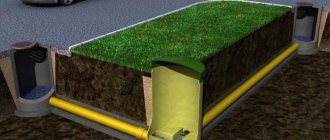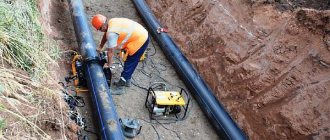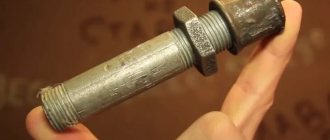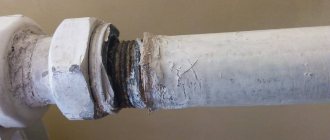Sewerage
Author Anton
Date
Jan 28, 2016
0
1 656
Share
Early in the morning, like all normal people, you go to the bathroom to wash your face, or even take a shower, turn on the tap, but there is no water in the tap. You are a resident of a private house, and it is useless to complain about the water supply services. Outside the window there is frost that has colored the glass. And it contains an explanation of the reason why there is no water in the tap. These are frozen pipes. And if you don’t take action, you can be left without water for a long time.
- Option one: pick up the phone and call the appropriate service. Specialists will arrive with a powerful steam generating unit and other tools and help melt the ice in the pipe. But you will have to pay for this service.
- Option two: go into the basement and look for a place where the water supply has frozen.
- LiveJournal
- Blogger
Ice accumulation in a pipe can rupture it from the inside.
- Homemade pipe heater.
- Hot water
- Defrosting ice with steam
- How to avoid freezing pipes
If the basement is not heated in any way, and the communications are not protected by thermal insulation, it means that they could freeze in the basement or on the street. Then the solution to the problem lies on the surface. All means are good in the fight against frost. The ice plug formed at the edge of the open pipe is drilled out with a conventional drill.
It is necessary to increase the air temperature in the basement and warm up the pipes. To heat a plastic water supply, a construction or industrial hair dryer or a heat gun is suitable. Only the temperature of the air produced by the hairdryer and the directed air should not exceed 80 ° C, so as not to deform the plastic.
Steel pipes are heated using a welding machine; you just need to secure the contacts at different ends of the collector and turn on the device, observing safety precautions. The metal will heat up and the ice in them will melt in a matter of minutes. But this method is not suitable for plastic pipelines, because plastic does not conduct electricity.
Another, slightly exotic way to defrost a pipe is to wrap it with a rubber hose and connect the hose to a source of hot water. The water passing through the hose will warm the pipeline and go down the drain. A warm hose will serve as an additional measure of heating, because when the pipes are heated by a hair dryer at one end, at the other they have time to freeze again.
If the pipeline runs above the freezing depth of the soil, then the cause must be sought underground. And this is much more difficult. You need to try to melt the ice in the pipe.
Homemade pipe heater.
You can make a homemade electric heater. To do this, you will need two insulated pieces of copper wire with a cross-section of 2.5 mm and a length of 1.5-2 m. The length of the improvised boiler should be greater than the expected depth of pushing the tool into the pipe. If you need to melt ice at a distance of three meters, then take the wire 3.5-4 meters.
Strip the wire from one end to 4-5 cm. Now bend the stripped end of one of the pieces where the insulation ends and wind it in neat turns (3-5 turns) onto the insulated part of the wire.
The turns should not touch each other. Now, next to the first turns with an indentation of 2-3 mm, wind the bare edge of the second wire with the same spiral, also 3-5 turns.
Cut off the excess ends of the coils with pliers and press them to the body of the base. Connect the separated wires with a strong thread, wrap it around the wires and tie it so that during operation the turns do not loosen and creep onto each other. Adhesive tape will not work for fastening, as it will get wet in water and will not hold. Align the other end of the wire by biting off the longer end and attach the plug. The ends of the turns should not protrude or cling to anything. Press them down with pliers.
- LiveJournal
- Blogger
Wire on pipes is one of the simplest ways to defrost
Now insert the boiler into the pipe (there must be some amount of water in it) and plug it into the outlet.
As the ice melts, move the boiler deeper. Such a tool does not threaten to melt plastic pipes, since while heating the water, it itself remains cold. Its action is based on electrolysis.
When pipes can freeze
Each region has its own climate characteristics; in some places frosts occur earlier, in others a little later. The duration of the cold period also varies. It is possible to determine when and how quickly the communications will freeze if it was not possible to insulate them before the cold season: it all depends on the type of system and the air temperature.
In the above-ground parts of the water supply system, water will freeze already at 0°C; underground pipes will stop passing liquid when the soil freezes to the depth at which they are located. Approximate levels of soil freezing in different parts of the country are presented in Table 1.
Table 1
| Area | Soil freezing depth, average, cm |
| Stavropol, Krasnodar | 60-80 |
| Kursk, Belgorod | 100 |
| Moscow, St. Petersburg, Ryazan, Novgorod | 140 |
| Uralsk, Samara | 160 |
| Perm, Ekaterinburg | 190 |
| Novosibirsk, Omsk | 220 |
| Surgut, Nizhnevartovsk | 240 |
In some regions, the soil freezes so deeply that it is still impossible to do without insulation, since digging a very deep ditch in a garden plot is too expensive and this will create inconvenience for servicing the system. If the water supply or sewer system was not properly prepared for the cold, you need to stock up on the necessary heating tools in advance and prepare for repairs. You can restore the functionality of pipes using heat, saline solution and technical means.
When choosing a method of work, you need to take into account the material from which the pipes are made
Hot water
Some craftsmen have adapted a motor from a car washer to defrost pipes. To work you will need
- Motor from car washer;
- Electrical wire;
- adapter for converting voltage to 12 volts so that the motor can be connected directly to the home electrical network;
- hard car hose 2-5 meters, depending on the length of the pipeline that needs to be heated;
- a bucket of hot water to melt the ice in the pipe.
One end of the hose is connected to the motor, which is located in the bucket, and the other is pushed into the water supply. Hot water will melt the ice, you gradually, as the ice melts, push the hose further until you melt the entire ice plug and the water begins to flow at normal pressure.
Ordinary table salt will serve as an auxiliary means for defrosting pipes. If you dissolve half a pack of ordinary table salt in a bucket while heating water, the thawing process will occur faster.
This method is ideal for both plastic and steel pipes. It can melt water pipes and sewers.
Preventive measures and communication rules
To ensure that the methods described above are never useful to you, you should design and build sewerage and water supply systems only in accordance with SNiP. Today, information about climate conditions is quite accessible, and it is imperative to use it. If it is not possible to lay pipes deeper than the freezing point of the soil, they should be insulated. For this use:
- Styrofoam.
- Mineral wool.
- Polyurethane foam.
- Foamed polyethylene and rubber.
- Heating cables.
There is no point in saving on thermal insulation, otherwise you will have to do heating regularly in winter. In addition, such materials can reduce heat loss.
Properly selected thermal insulation reduces heat loss
Melting ice in a frozen water or sewer pipe is not an easy task. It becomes even more complicated when ice forms in underground communications. And although there are many ways to combat this phenomenon, it is still easier to prevent it. Pipes should be laid at a specially calculated depth and heat-insulating materials should be used.
How to avoid freezing pipes
If pipes freeze in the basement, you need to consider insulating them immediately after you defrost them. Buy a heating device (heating cable or infrared film) and thermal insulation for the pipes for the problem area of the pipe. Thermal insulation material will reduce the cost of electricity used for heating.
Important. Before laying down and connecting the heating device, carefully read its instructions. Because each heater has its own installation method.
WATCH THE VIDEO
Some heating cables or tapes are wound in a spiral, and the heating effect is based on such a spiral winding, while others, on the contrary, must be laid along the pipe, avoiding twisting and wrapping. Some tapes or cables can be cut and laid into sections as you see fit, and where necessary, the integrity of others, on the contrary, cannot be violated.
What product will melt the ice when it’s 30 degrees outside?
What product will melt the ice when it’s 30 degrees outside?
Epiphany frosts have arrived in Siberia; for two days now the temperature has not risen above -30 degrees. In such cold weather, the snow freezes and ice forms. Standard deicing agents are useless at low temperatures, the sand-salt mixture works down to -10 degrees, and the janitor simply physically cannot stay outside for a long time.
What products will help remove ice at temperatures below -30 degrees?
Our line of de-icing materials includes two products that continue to work even at low temperatures. These are Bionord-Universal and Aquais -31.
Bionord- Universal is a completely soluble granule of irregular shape (1mm-5mm) with an optimally selected composition of components that allows melting snow and ice deposits at subzero temperatures.
Advantages:
- high speed of ice melting (from 15 to 30 minutes);
- operates at temperatures down to −35°C;
- low consumption;
- the material completely dissolves and does not clog storm drains;
- minimal impact on leather and fur products;
- accelerated removal from the soil, preventing its salinization;
- does not harm coatings made of concrete, asphalt concrete, tiles and stone.
Aquais-31 is a small white granule. When in contact with snow and ice, the reagent particles have the effect of melting the ice crust, due to which the ice peels off from the surface. Loose ice must be removed. After cleaning, the Aquais -31°C reagent does not leave any traces on both the asphalt road and decorative paving slabs.
Advantages:
- high melting ability due to calcium chloride;
- completely soluble material;
- after cleaning it does not leave marks on asphalt and paving slabs;
- melts ice at temperatures down to -31°C.
Are you interested in anti-icing agents that are not afraid of Siberian frosts? Then send your order to our email
Can't decide on the choice of deicing agent? Then call us and our specialist will advise you for free: +7 (383) 363-02-93
To familiarize yourself with the entire line of deicing products, go to our website: stop-led.ru
Come to our office and we will give you free samples of various anti-icing agents: Novosibirsk, Zaeltsovsky district, st. 1st Eltsovka, building 1, business park "Eltsovka-1", 4th entrance, 2nd floor, 17th office.
Opening hours: from 9:00 to 17:00, Saturday/Sunday - days off.
Warm garage or parking lot
The car can be driven into a warm place (for example, a garage or parking lot) for several hours. The method is indeed very effective, but it will take a lot of time, which is not suitable for everyone. Its advantage is that the ice thaws in all places at the same time.
In this case, there are a number of difficulties that the driver may encounter:
- Finding a warm place. If you don’t have your own heated garage, then finding a suitable room is quite difficult. You will have to try to find parking in the city and pay a certain amount for parking.
- Time. Not every driver can devote several hours to get his car in good condition. However, if there are no restrictions, then it is better to use this method and spend your free time in a cafe or go shopping.
Frozen water in the tank is a fairly common problem among motorists. There are ways that will quickly and painlessly correct the situation. But it is better to avoid such situations, which are poorly displayed on the condition of the tank and auxiliary elements.
How to prevent ice formation
Sometimes it is much easier to eliminate the cause than to bother eliminating the effect. This also applies to the formation of ice. There are several tips that will help you avoid freezing or significantly reduce it.
Ventilate the interior
Before leaving home from the parking lot, take the time to open all the doors or windows and ventilate the interior for 3-5 minutes. This will equalize the temperature inside and outside, and reduce the likelihood of icing. Additionally, you can turn off the heating in advance when approaching the house or even open the window a little.
Cover the windows
If you cover the glass with some material, then ice will form on it, not on the glass. Motorists use unnecessary blankets, cardboard and film for this, pressing them with the help of windshield wipers and doors. The film is best suited because it does not absorb moisture and does not get wet. Due to this, it does not need to be dried and it does not freeze to the glass.
Carry out hydrophobic treatment
Another option for passive protection is applying “anti-rain” and other products with hydrophobic properties to the glass. They repel moisture, preventing it from lingering on the glass, so the most that will be on it after a frosty night is loose frost, which is easy to clean even without a scraper.











